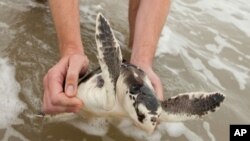"Two hundred million years ago, turtles lived on land. When the dinosaurs came, they ran to the sea and became creatures of the tides."
Those words mark the start of "Turtle: The Incredible Journey," a film about the migratory cycle of loggerhead turtles.
Filmmaker Nick Stringer follows a female turtle’s journey from a sandy Florida beach, across the Gulf Stream to Newfoundland to the Azores, back to the Caribbean and, years later, back to Florida. It's a years-long journey that only one in 10,000 loggerheads survives, putting the turtles' long-term survival at risk.
The film opens as hatchlings emerge on a Florida beach. They struggle to dig themselves out, escape predatory crabs and begin a journey in the seas. The documentary follows one of those turtles in what filmmakers call nature's greatest survival story.
British actress Miranda Richardson narrates as the film follows the turtle on a 15,000-kilometer migration, guided only by instinct.
Along the way, our turtle dines on jellyfish. Migrating dolphins and a small shark will accompany her on parts of the journey. But she will also dodge perils, both natural and man-made.
“They go back to the beach where they were born to lay their eggs," says Richardson, who is also an ambassador for the World Wildlife Fund. "That’s what they do. If there is no beach, they can’t lay their eggs. If there are oil spills, they can choke and die. If there are plastic bags, which they mistake as jelly fish because they don’t know any better, they can die.”
Richardson says some steps have been taken to help the turtles survive, like protecting beaches where turtles lay their eggs and creating hatcheries on some beaches.
“There are protected beaches. The turtles are excluded from shrimp trawlers by these TEDs, Turtle Exclusion Devices. They have a 99 percent chance of success.”
In 1987, the United States required shrimpers to use TEDs, a kind of trap door on trawling nets so turtles can escape if caught in them. But shrimpers, especially in the Gulf of Mexico, have reportedly resisted using these escape hatches.
Dean Blanchard, a third generation shrimper, owns Dean Blanchard Seafood in Grand Isle, Louisiana.
"We don't have any problem with TEDS," he says. "The only problem we have right now is that they send agents that don't know how to measure TEDs. They are giving all boats tickets. We're using it the right way. We're not killing any turtles."
Richardson says humans must do more.
“I think we know that we are, as a species, very wasteful, and we have to clean up our act. And then we give the turtles and other marine mammals the best chance they can possibly have."
In the film, our turtle beats the odds by braving the elements and making it back to Florida to lay her eggs.
Richardson hopes the film will raise awareness among the younger generation, so that the loggerhead turtle's migratory journey isn't made any more perilous than it already is.












